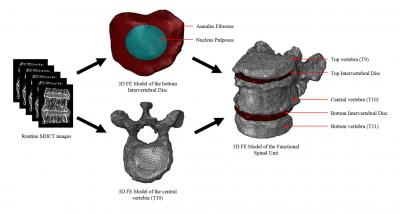This enables more accurate patient-specific analysis in a non-invasive manner, providing timely opportunities for early treatment

Credit: SUTD
Osteoporotic vertebral fractures (OVFs) are a prevalent skeletal condition in the elderly, which occurs due to a net loss in bone density with the inevitable onset of aging. Unfortunately, they are largely under-diagnosed until detected by clinicians through radiological scans. These fractures have a huge impact on daily lifestyle as the spine is responsible for bodily movements and stability. However, the mechanism behind these fractures remain unclear due to the complex physiological interplay between spinal segments. As such, the fractures are asymptomatic and not clinically noticed until it is sustained by patients.
Extensive research is ongoing in the investigation of alternative biomarkers to assess bone strength and consequently allow prediction of fractures before they are sustained. One such biomarker is the computational prediction of failure load through numerical simulation, also known popularly as finite element analysis. With this analysis, not only is non-invasive examination of the spine possible, but a holistic quantitative evaluation of the bone strength too.
Yet, most of the research is focused on the biomechanical analysis of vertebral segments in isolation. The spine consists of many different spinal segments, with majority of the loading borne by the vertebra and intervertebral discs. Hence it is essential to include these afore-mentioned load-bearing segments when considering the structural strength of spine. Functional spinal units have the advantage of mimicking the biomechanical requirements of the spine better than isolated vertebral segments.
This investigation, recently published in the Spine Journal by the Singapore University of Technology and Design’s (SUTD) Medical Engineering and Design (MED) Laboratory, in collaboration with the Technical University of Munich, introduced a semi-automatic computational clinical tool that aims to extract structural information, such as failure load, from radiological scans of patients using functional spinal units. Through this study, it was demonstrated that routine clinical scans can be a feasible resource for accurate prediction of OVFs using patient-specific finite element analysis of functional spinal units. These results will then pave the way for a spinal risk assessment tool to be developed and used by clinicians (refer to image).
Improved management of OVFs is essential amidst current clinical challenges. Understanding in detail the causes of OVFs will help organizations looking to tackle the increasing morbidity and mortality rates of the aging population, which poses unnecessary socio-economic burden on society. Implementation of a semi-automatic clinical tool vertebral strength assessment tool could also result in more accurate prediction of osteoporotic fracture risk and aid clinicians with better targeted early treatment strategies.
“Considering the world is aging rapidly, osteoporotic bone fractures are also increasing significantly. So, there is an urgent need to implement computational biomechanical analysis in the clinical scenario since it is a powerful tool for non-invasive evaluation of bone strength. Accordingly, this work lays the foundation towards extracting valuable structural information from improved spine models, such as functional spinal units, in the diagnosis of osteoporosis and prediction of OVFs,” said lead researcher, Assistant Professor Subburaj Karupppasamy from SUTD’s Engineering Product Development pillar.
###
Media Contact
Jessica Sasayiah
[email protected]
656-499-4823
Original Source
https:/
Related Journal Article
http://dx.




